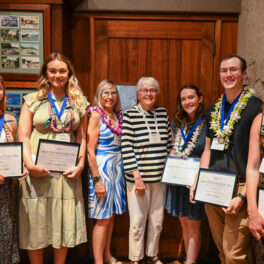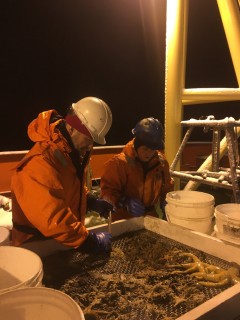Whitlow W. L. Au, emeritus research professor at the Hawaiʻi Institute of Marine Biology (HIMB), has been named recipient of the gold medal of the Acoustical Society of America (ASA) for contributions to understanding underwater biosonar and for service to the acoustical society. The gold medal, which will be presented at the 171st meeting of the ASA on May 25, is given to a member of the ASA whose contributions to the field of acoustics and to the acoustical society have been unusually distinguished.
Au’s research has been devoted to understanding dolphin biosonar and to learning why it is so superior to man-made sonar. This involves understanding the properties and capabilities of dolphin biosonar, discovering how dolphins produce sound and how sound travels through the head and enters the water via their foreheads. It also involves understanding how the “special” type of signals produced by dolphins capture the essence of different objects. The ultimate goal is to design sonars that are based on the principles underlying dolphin biosonar.
“I am honored and humbled to receive this award. This is the first time that the Gold Medal has been awarded to someone who performed most of his research in Hawaiʻi,” said Au.
Au was born and raised in Hawaiʻi and attended St. Louis High School. He earned a bachelor’s of science in electrical engineering from the University of Hawaiʻi and a doctoral degree in electrical sciences from Washington State University. He served as a senior scientist at the Naval Ocean Systems Center, Hawaiʻi Laboratory from 1971 to 1993 after which he joined the Marine Mammal Research Program at HIMB as chief scientist where he continues today as emeritus research professor.
Sonar was invented just prior to World War I. However, dolphins have been using “biosonar” for millions of years to search for food and avoid obstacles. In shallow water and for short ranges below 200–300 meters evolutionary pressures over millennia have resulted in dolphin biosonar being considerably superior to man-made sonar.
“Doing research in science is fun and I am blessed to be able to spend a career having fun,” said Au.
Contributions to the scientific community
Au served on the National Research Council Ocean Studies Board (2004–06) and as chair or member of organizing committees for national and international meetings and symposiums including the International Symposium on Sensory Systems and Behavior of Aquatic Mammals (1991), the 3rd International Symposium on Animal Sonar (1996), the Acoustic Communication by Animals International Symposium series (2008, 2010, 2011), and Joint Meetings of the ASA and the Acoustical Society of Japan in 1996, 2006, and upcoming in the fall of 2016.
His service to ASA includes Chair of the Technical Committee on Animal Bioacoustics (1997–00), associate editor, Journal of the Acoustical Society of America for Animal Bioacoustics (1998–), member of the executive council (2001–04), vice president (2006–07) and president 2009–10). He was awarded the first ASA silver medal in animal bioacoustics in 1998.













